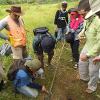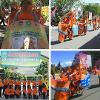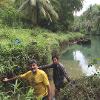Students and faculty members from the Departments of Earth Science and Public and Community Health participated in a tsunami research and education project in Java, Indonesia. The major goals of the project, which was headed by Dr. Ron Harris of BYU, were to assess the tsunami hazard along the south coast of Java, and educate and promote the safety of coastal residents from tsunami hazards.
The group from UVU was led by three faculty members: Michael Bunds and Daniel Horns from Earth Science and Sarah Hall from Public and Community Health. Geology major Jeremy Andreini and Community Health major Jessica Pettersson played a key role not only researching but helping to create and teach the tsunami safety curriculum throughout the community. Local community members included UPN University in Indonesia, the Indonesian equivalent of FEMA, and the Indonesian Institute of Sciences.
The findings of the research led to the development of the “20-20-20” educational campaign. Residents of the south coast of Java were informed that if they feel the ground shake for at least 20 seconds, then they have 20 minutes to reach 20 meters elevation. This message was delivered to over 3,000 people, including school groups, scouting groups, governmental agencies, and employees of coastal businesses. This educational effort should help those 3,000+ people, and their families and communities, stay safe during future tsunami events. Making the effort even more effective is the fact that the tsunami education effort has been adopted by the communities themselves. After the group from UVU left, at least one of those communities held a tsunami awareness parade, in which the 20-20-20 message played a prominent role.






